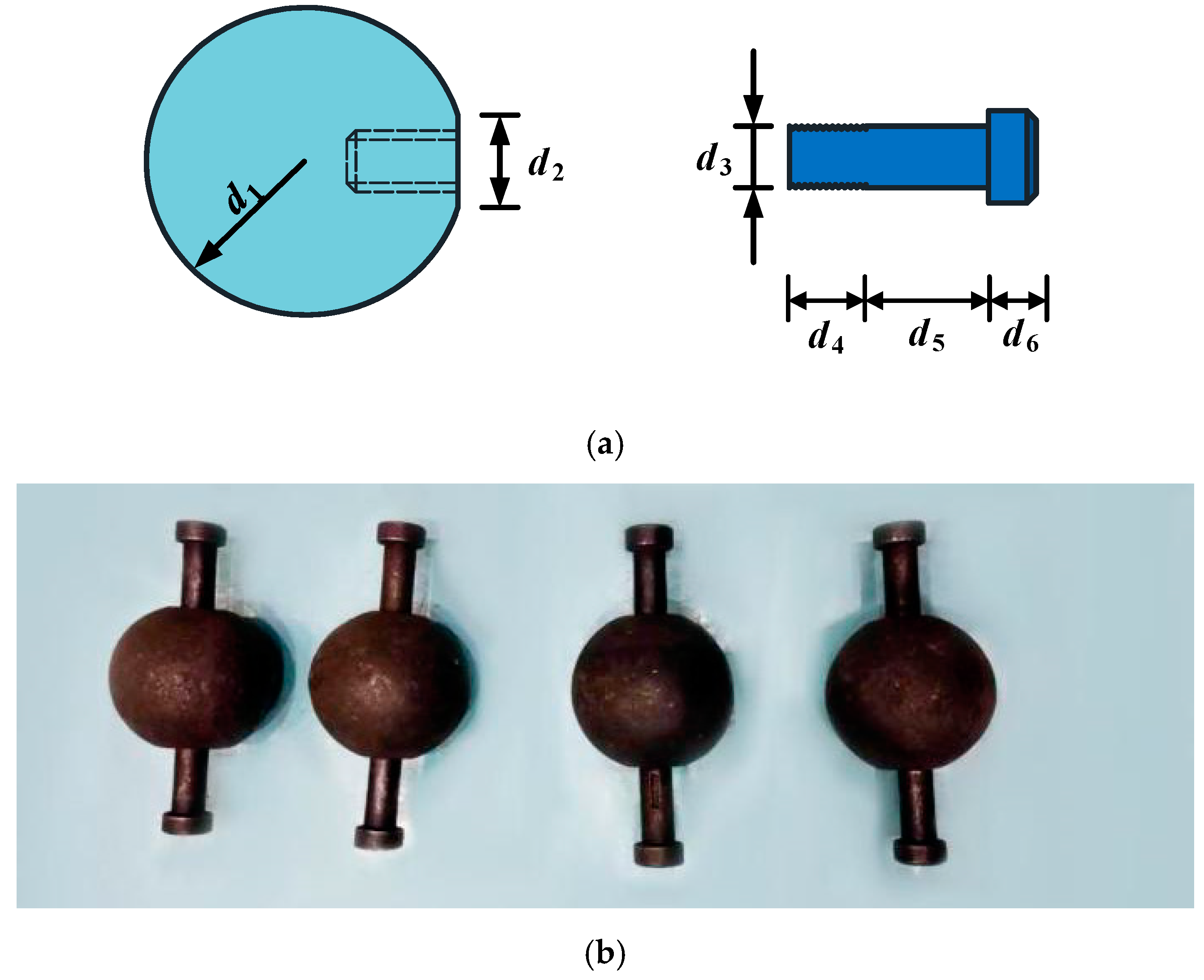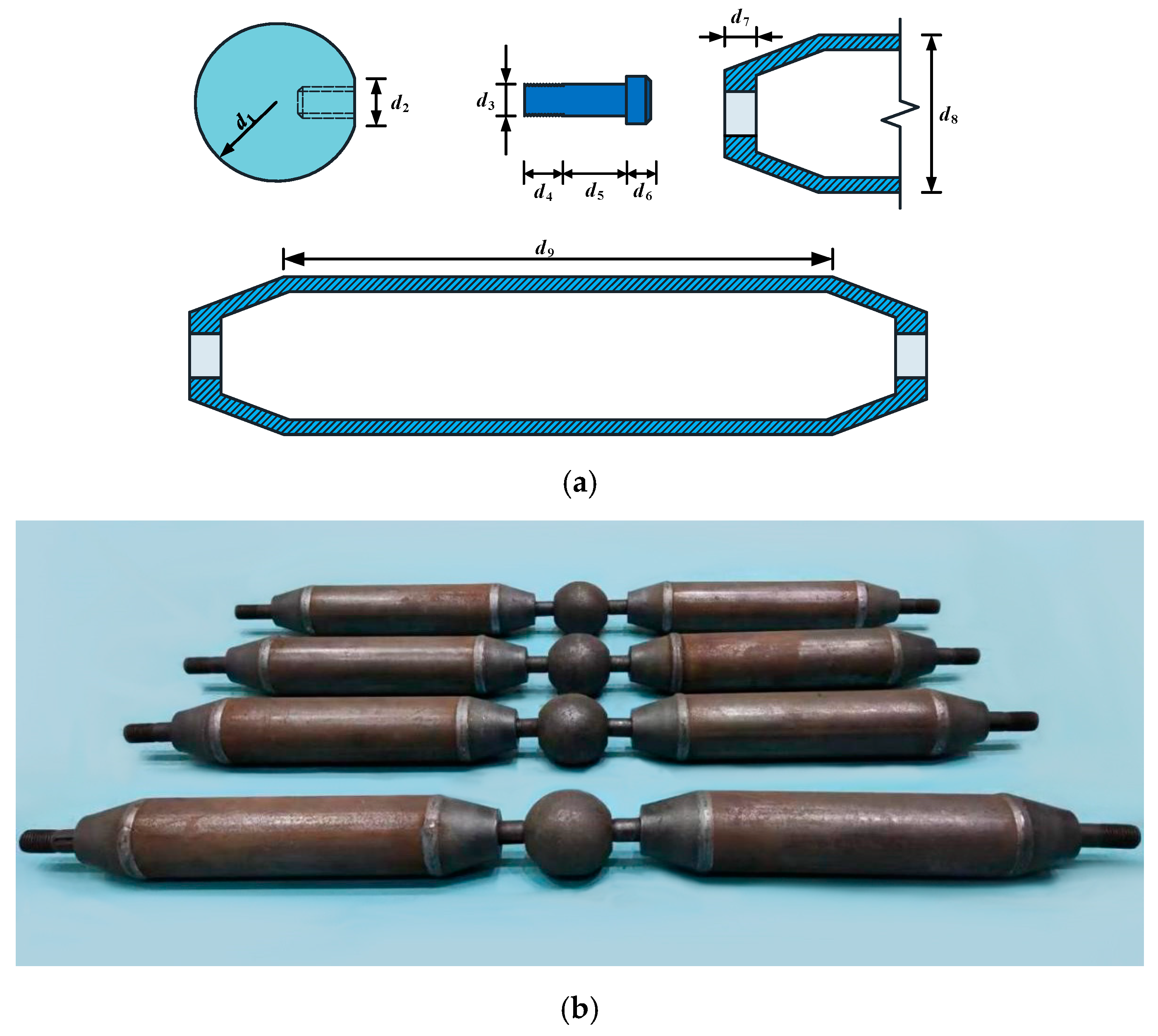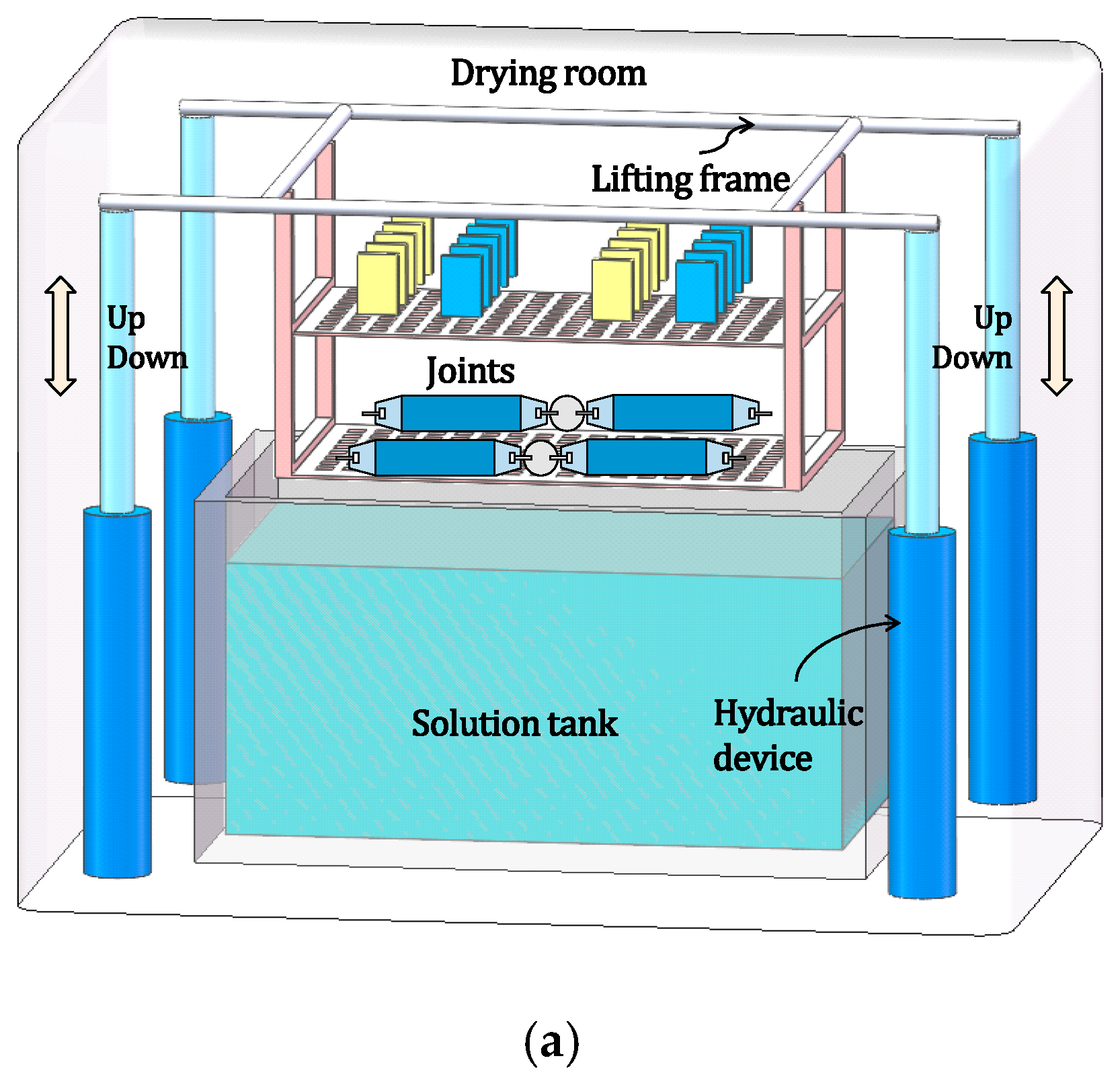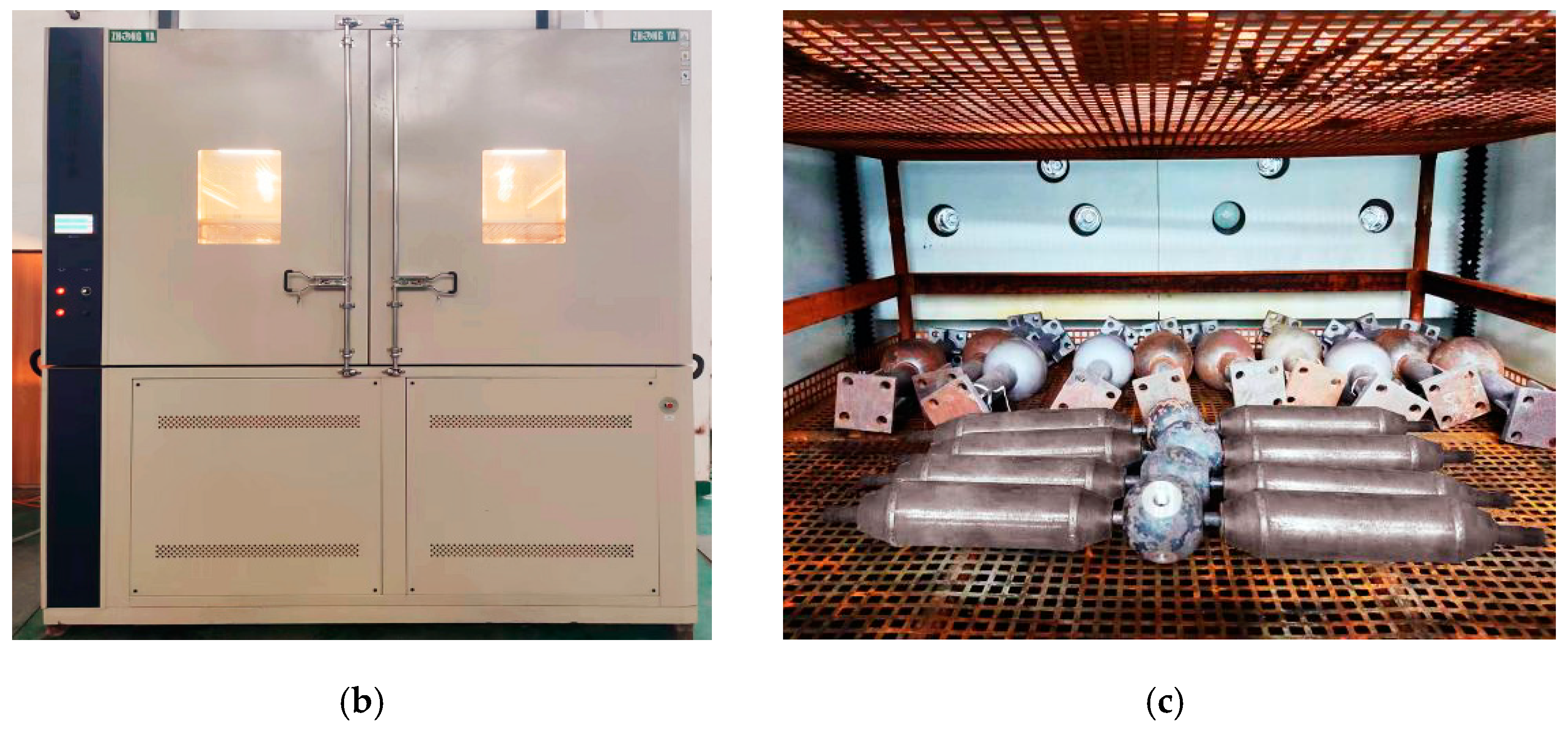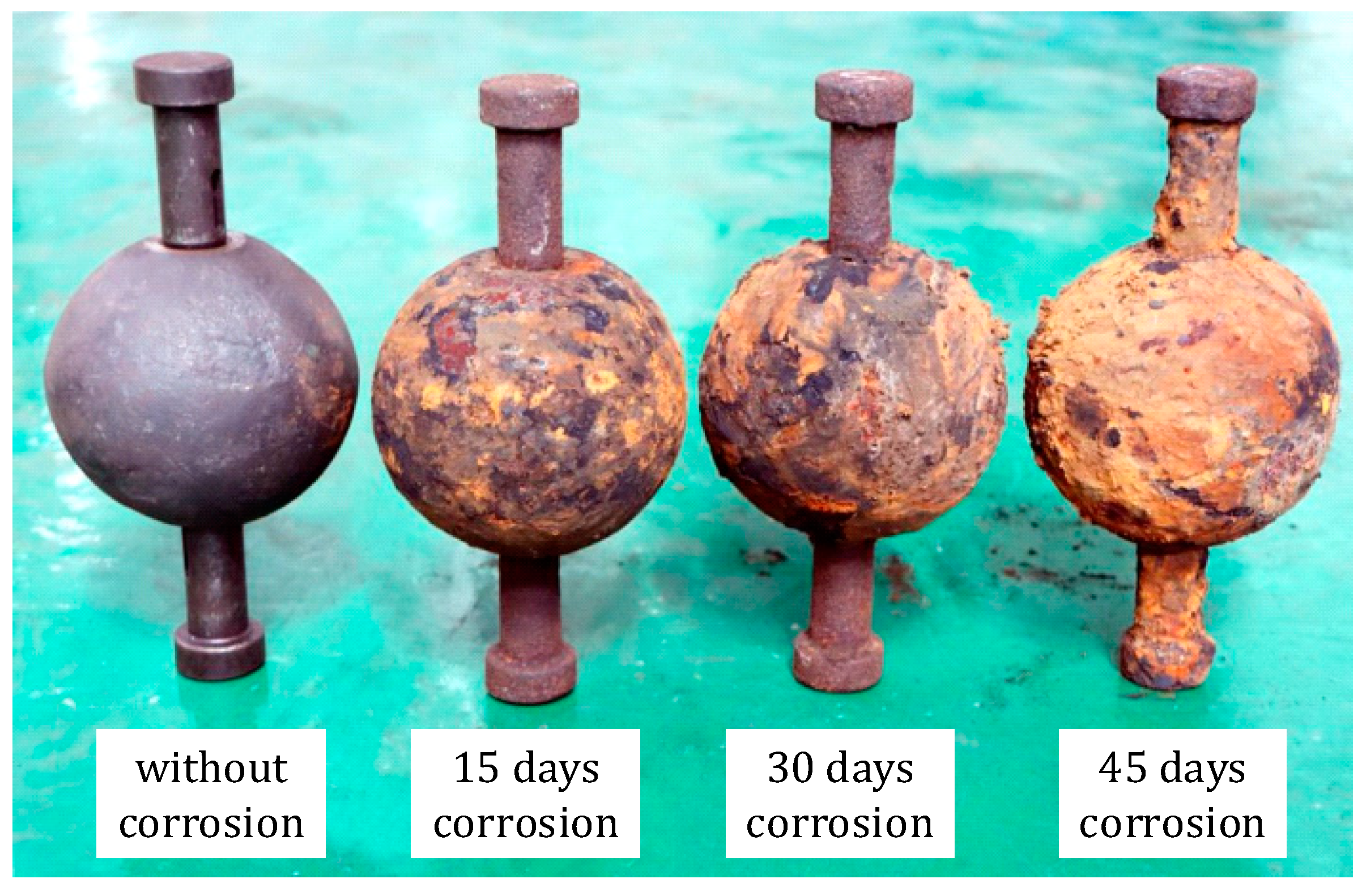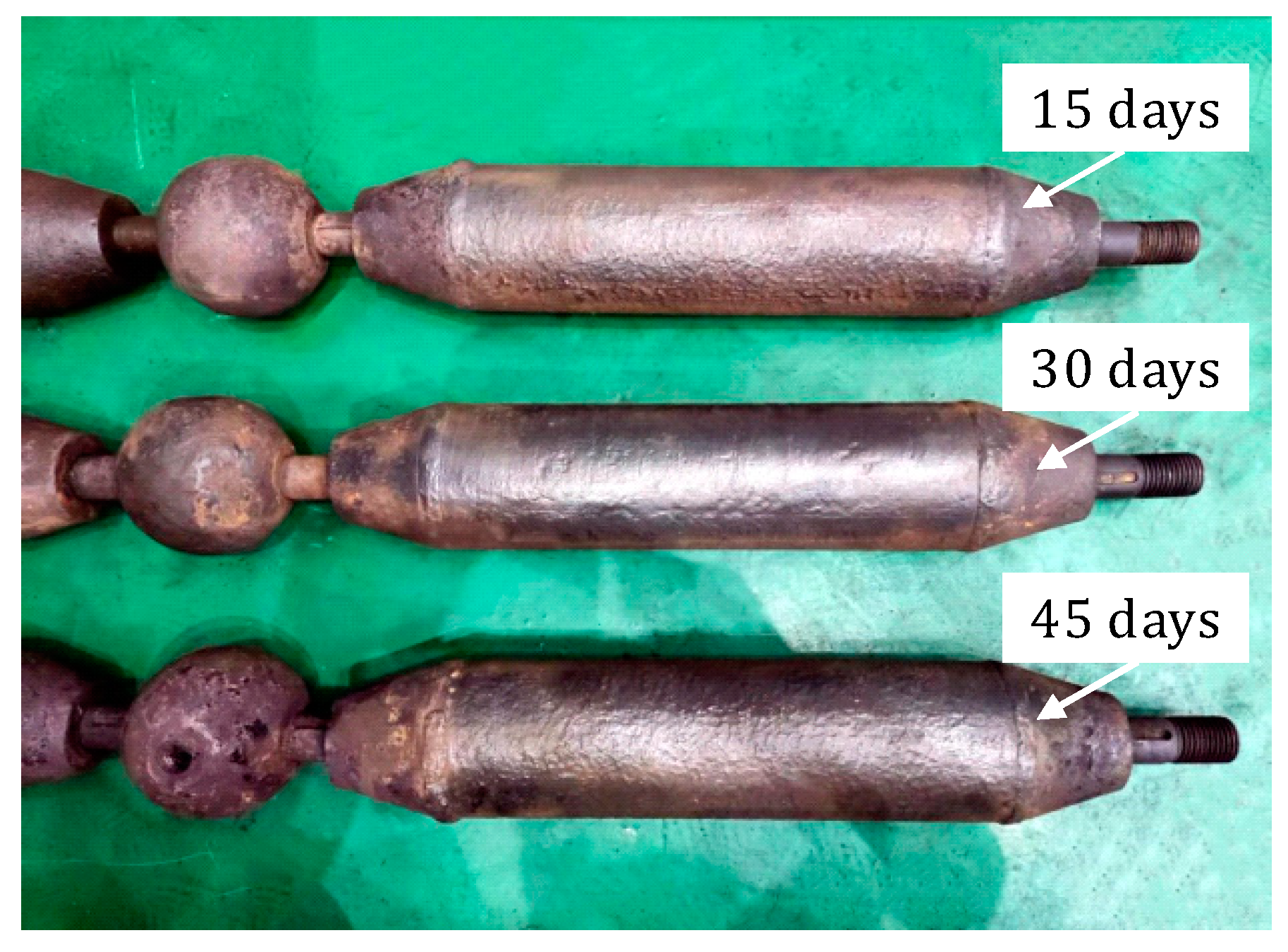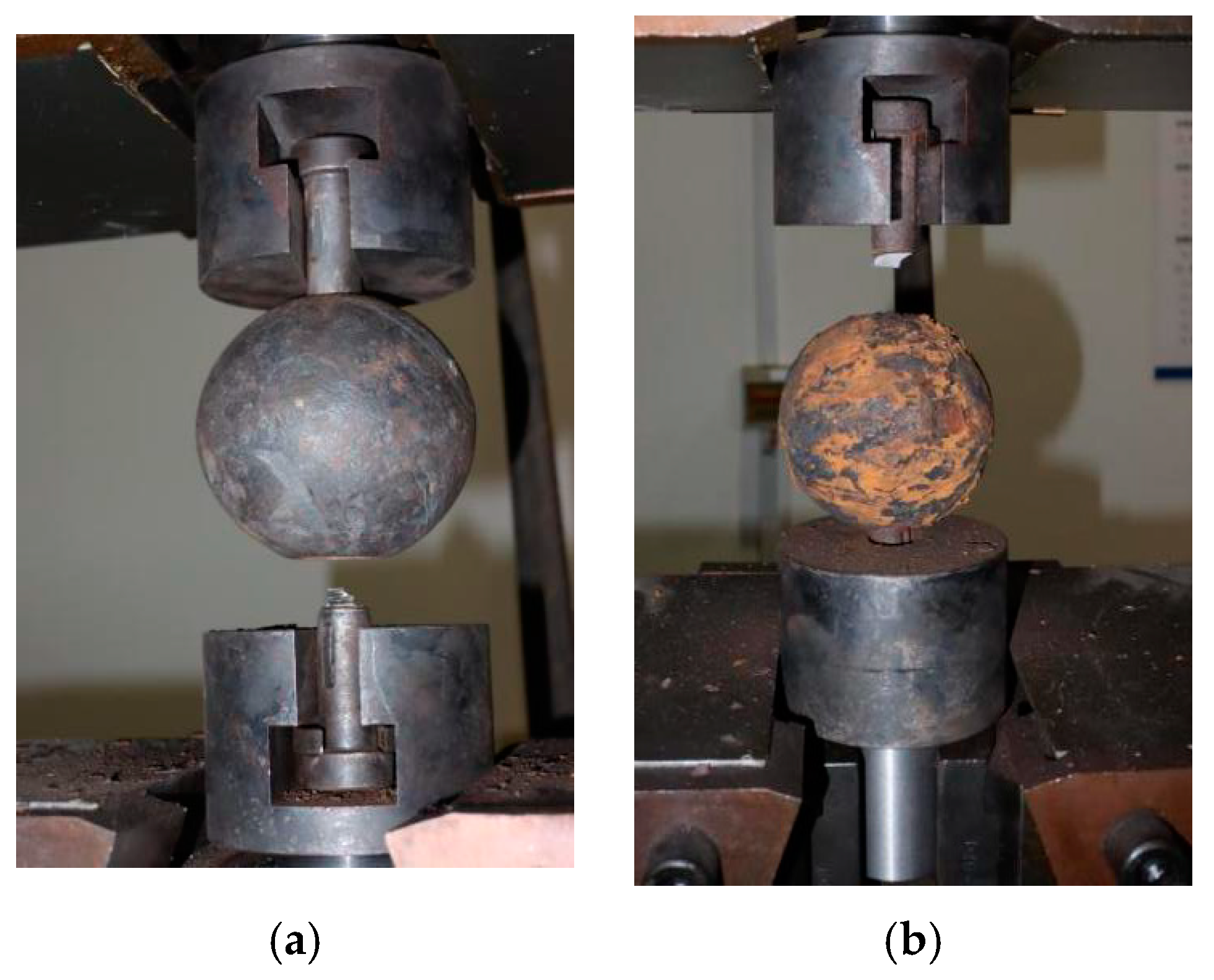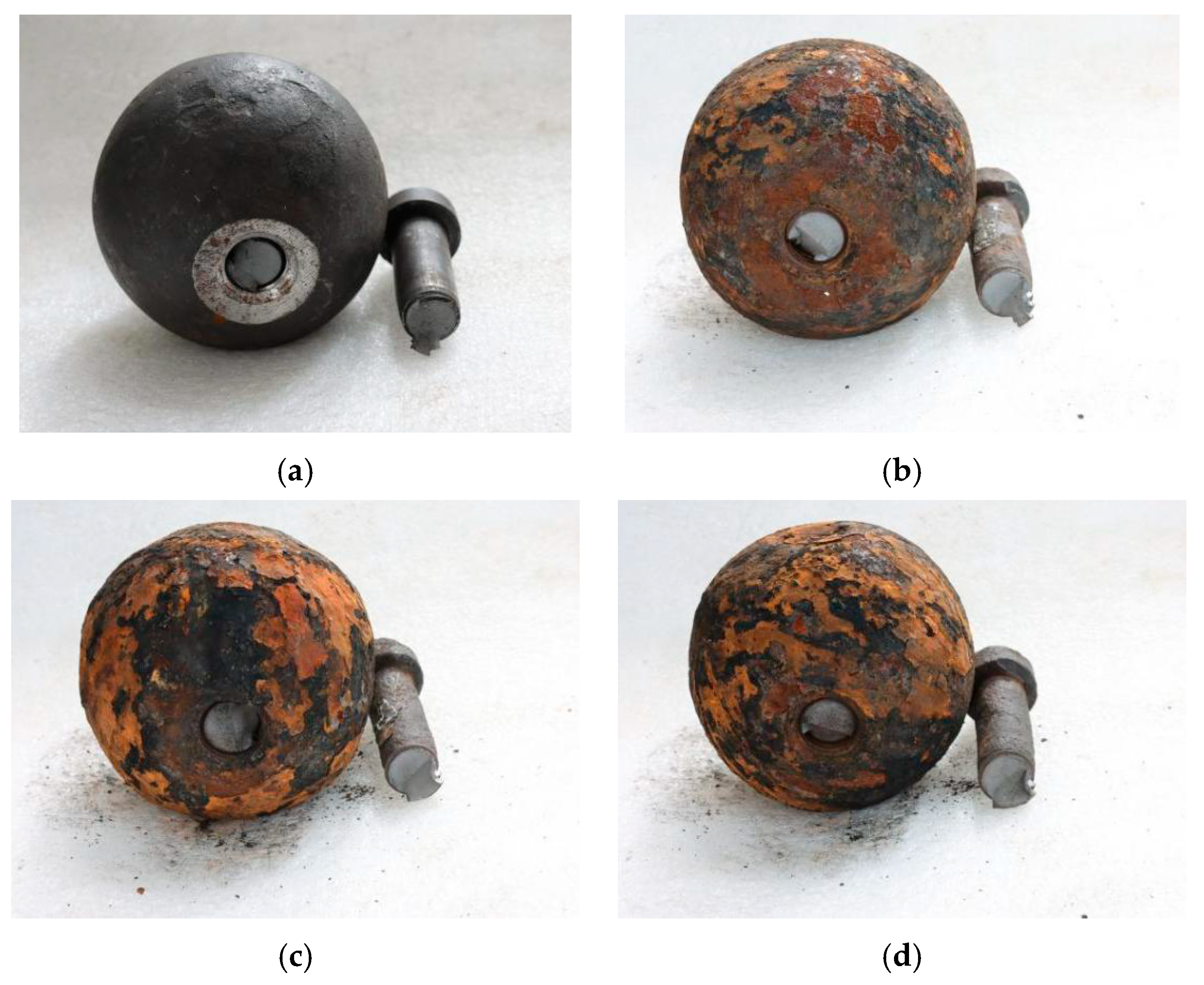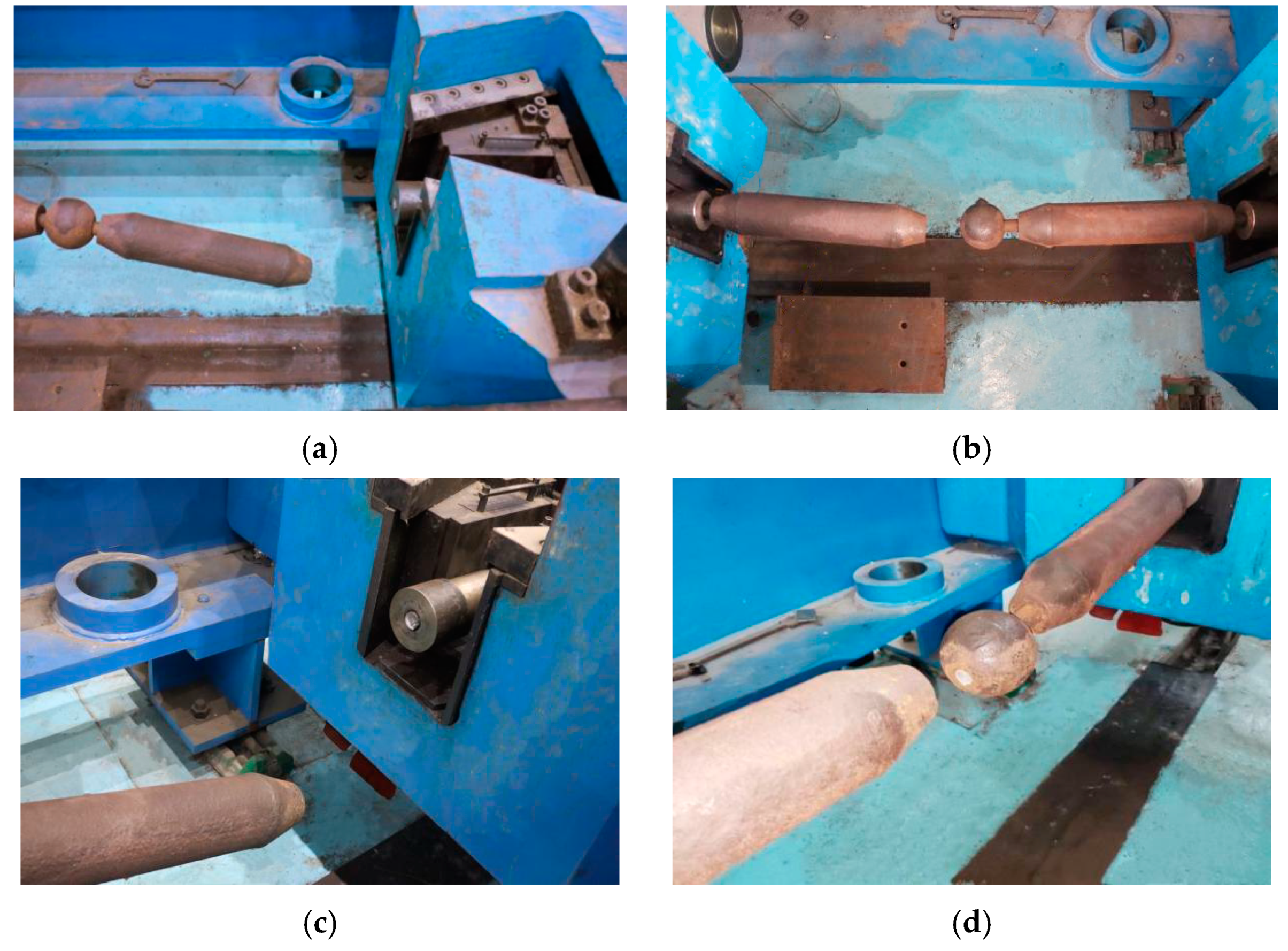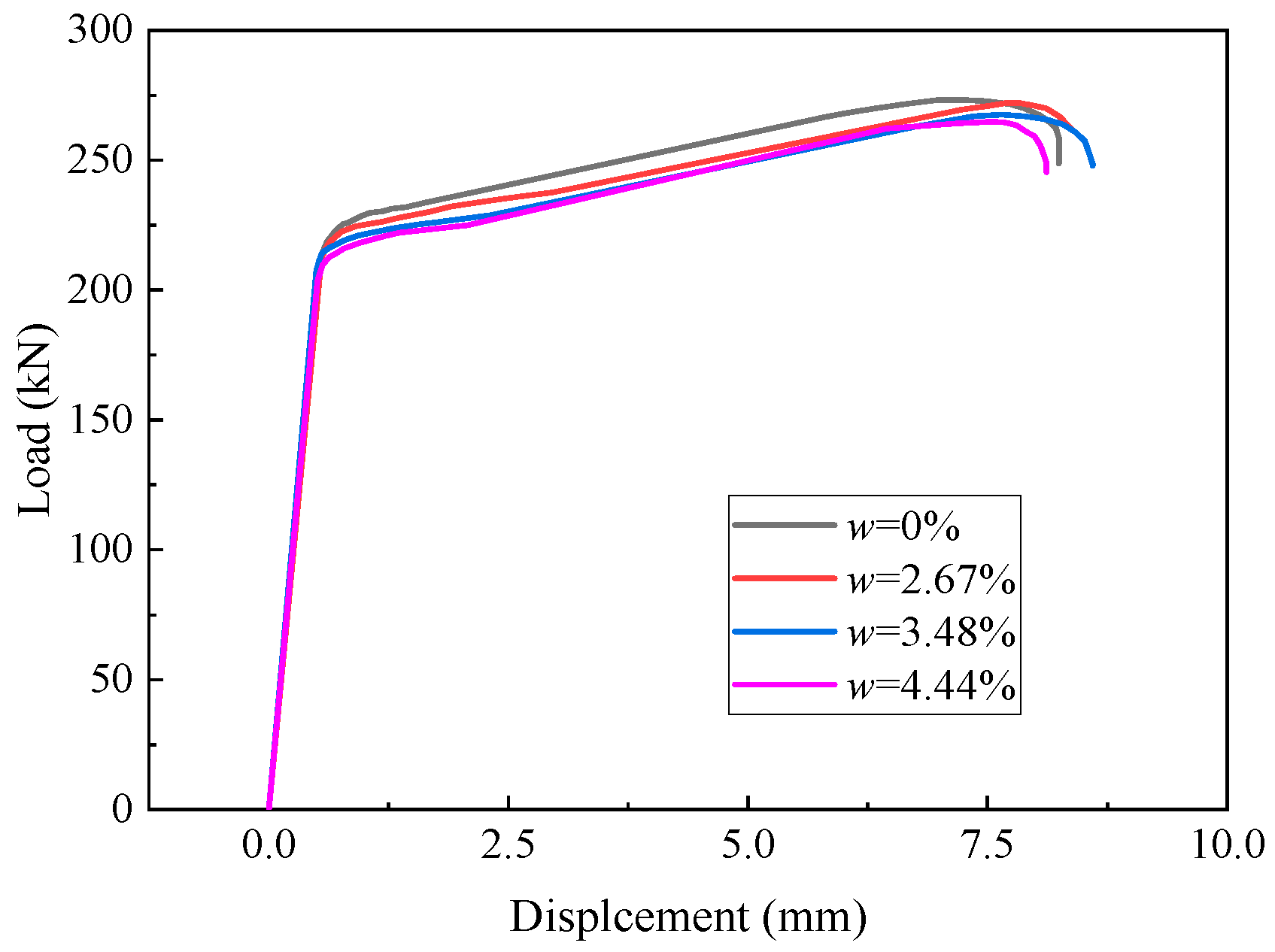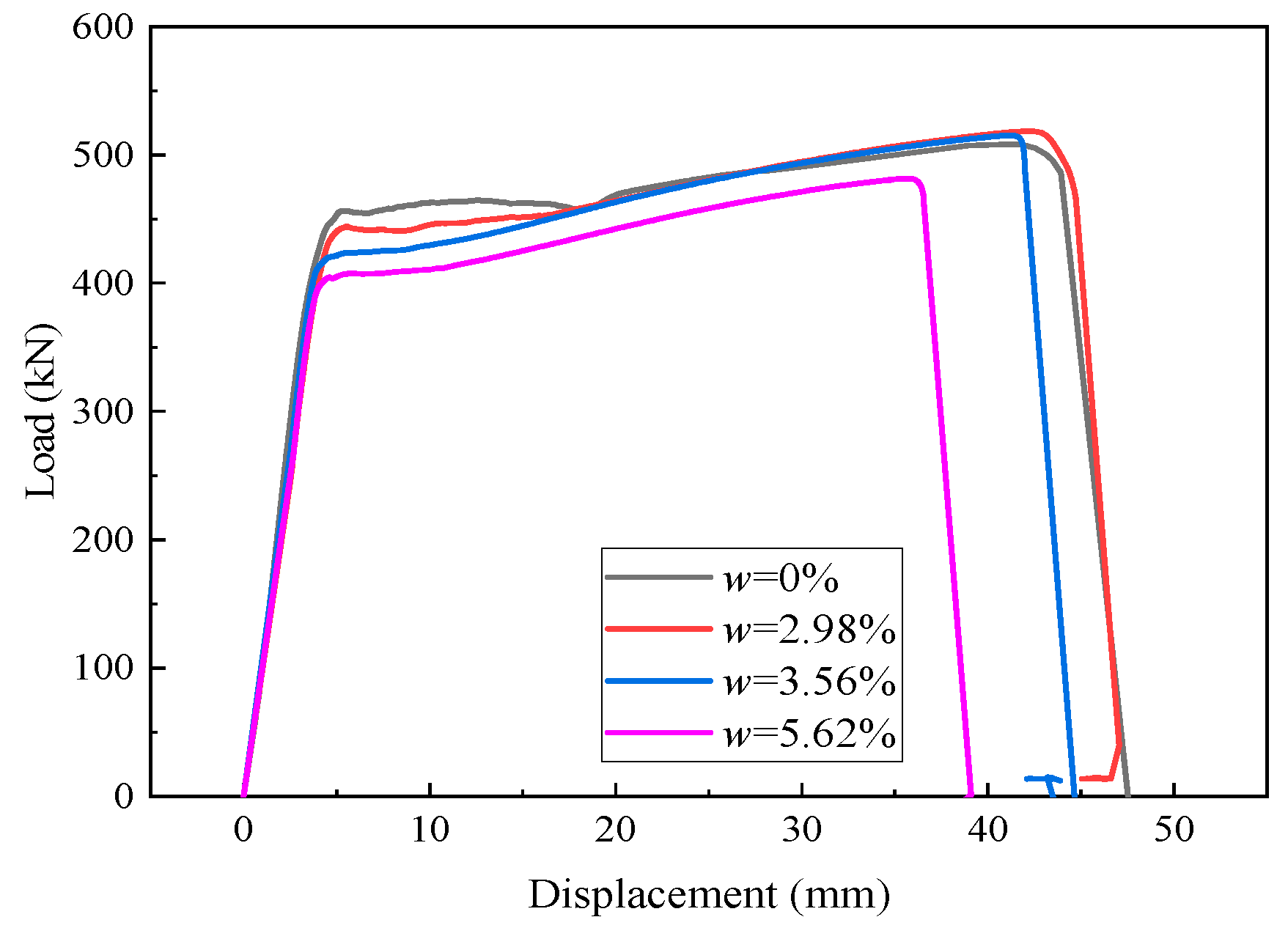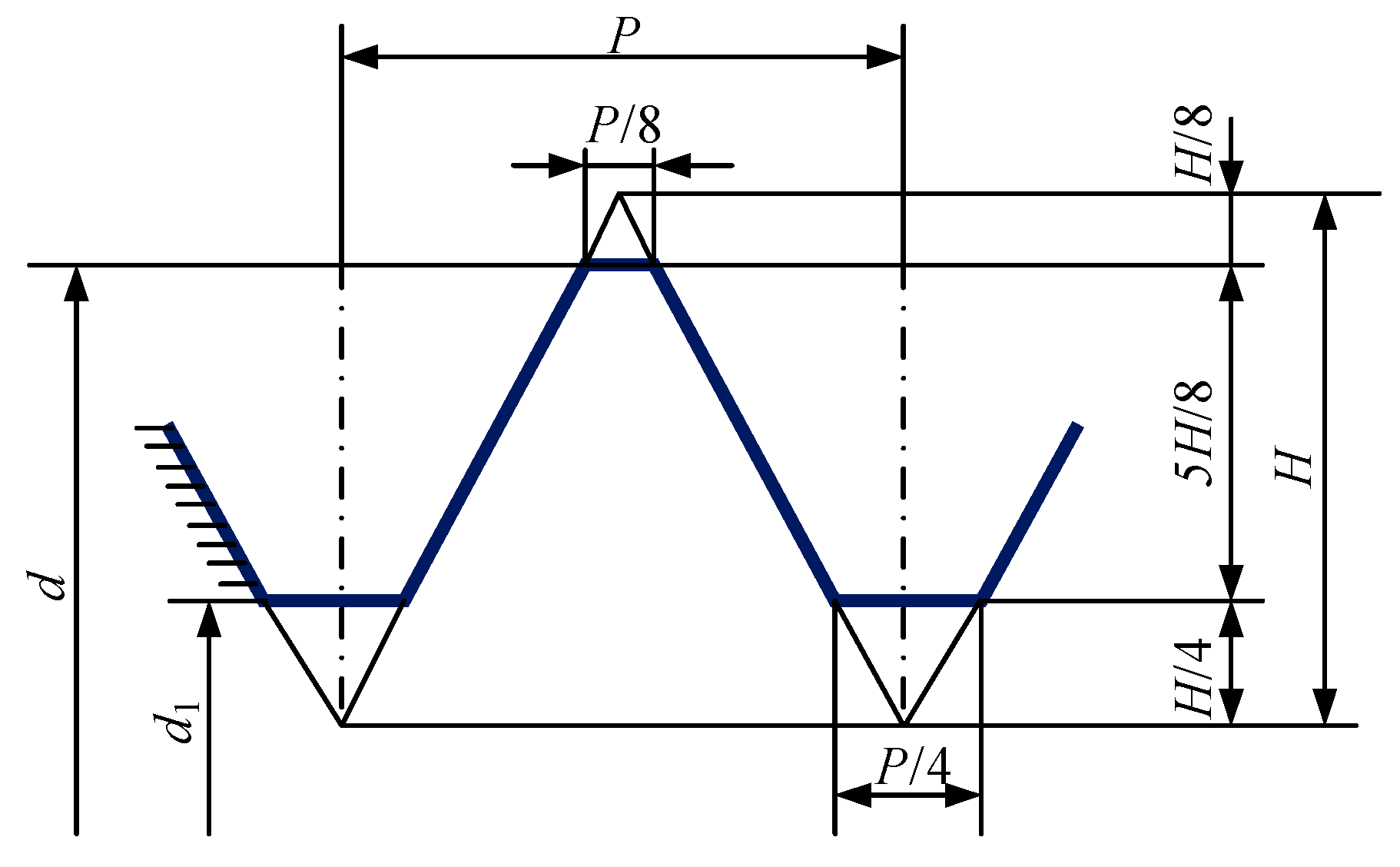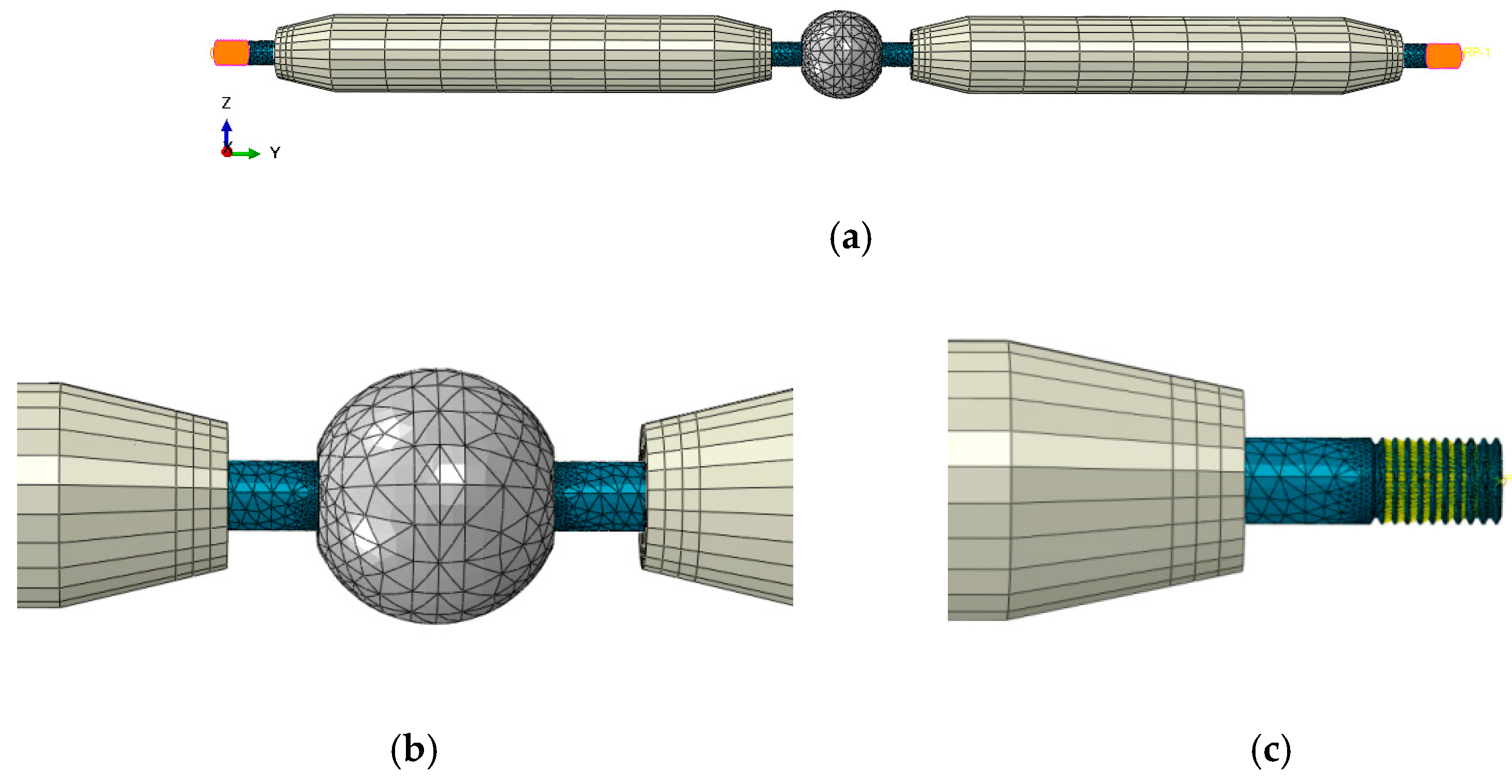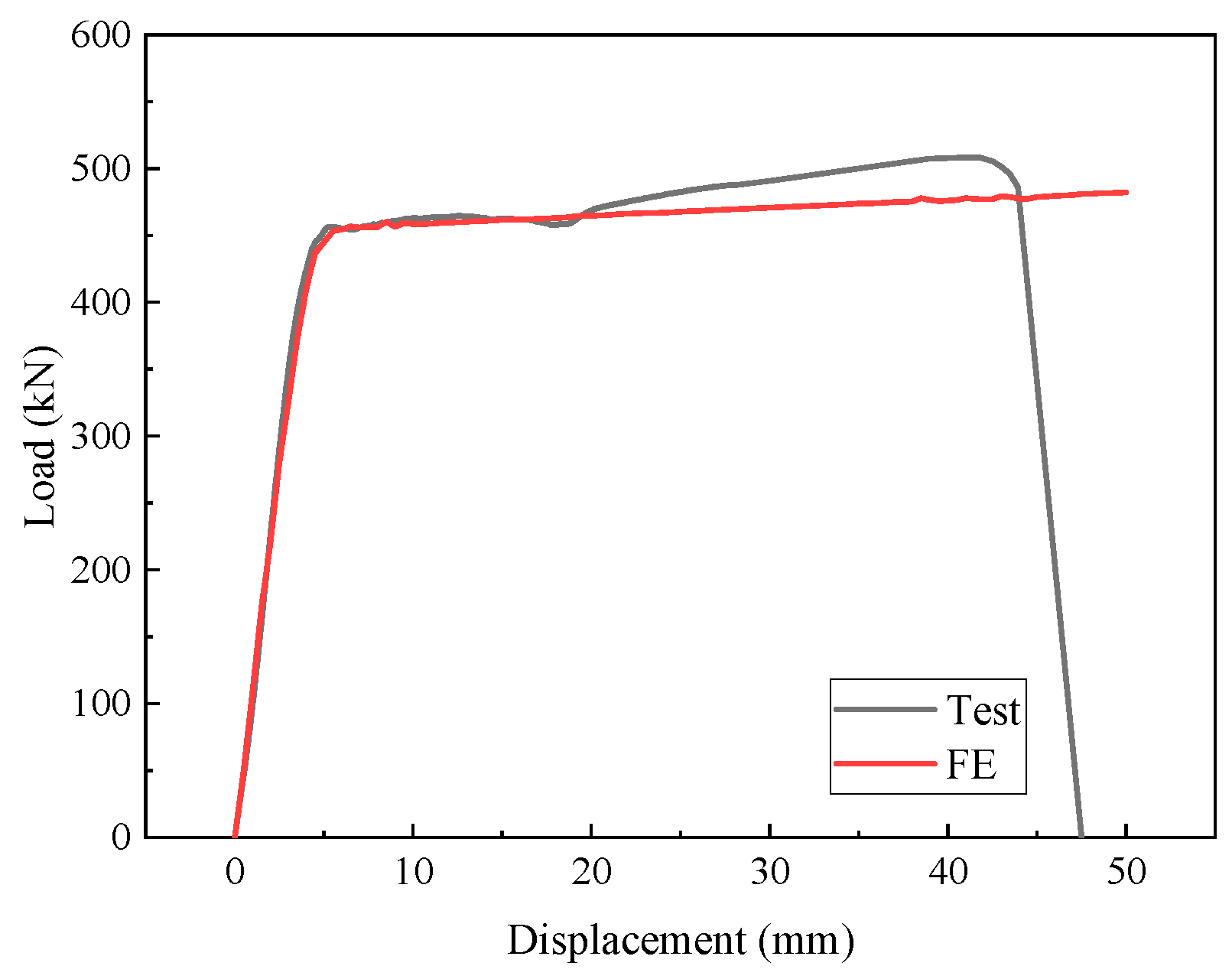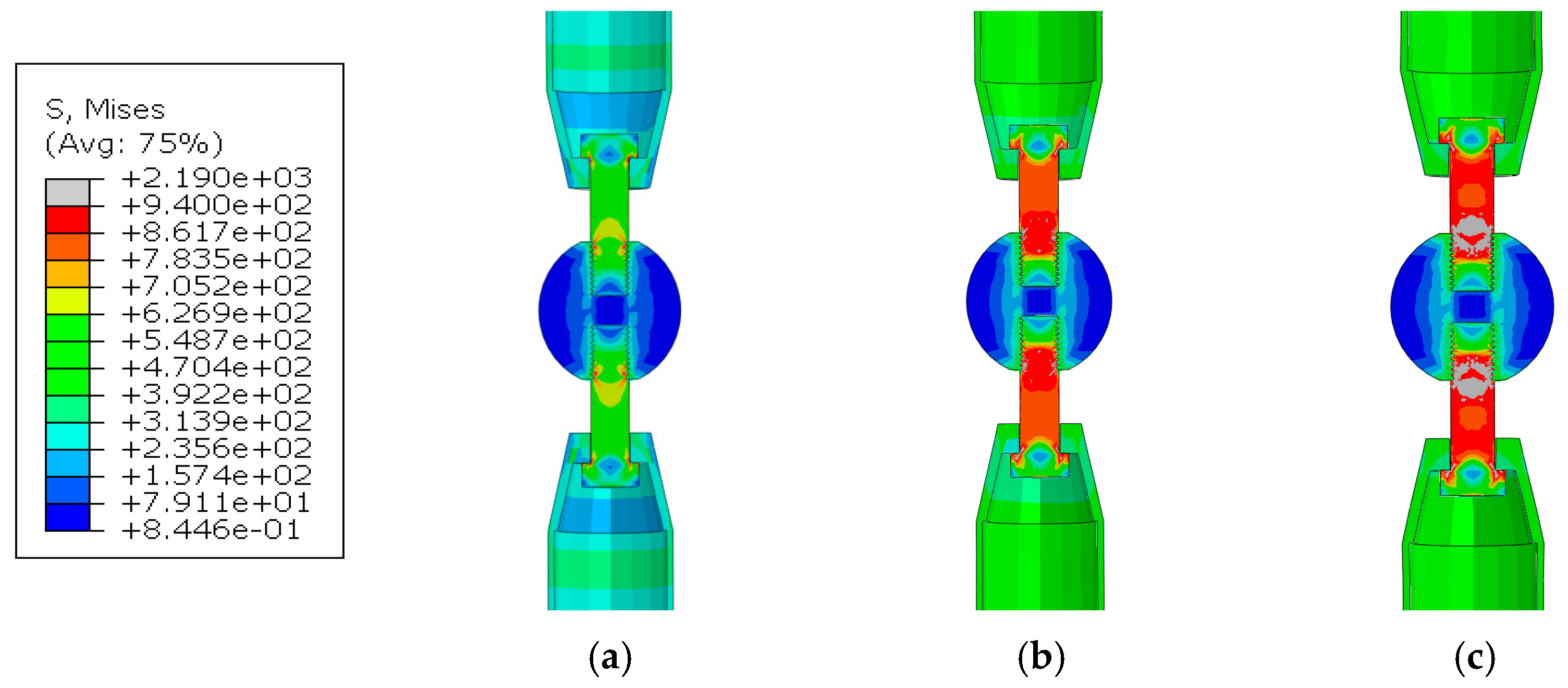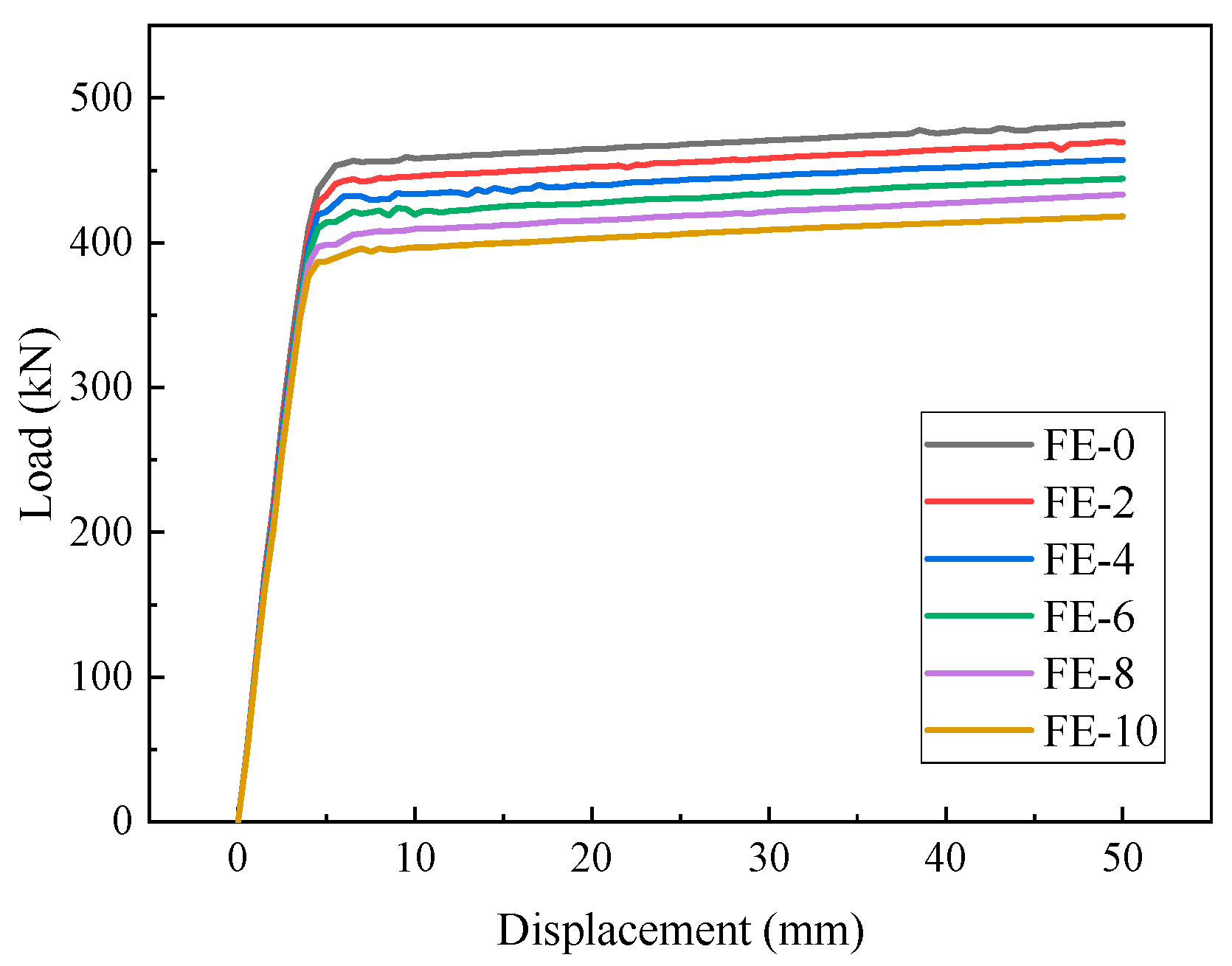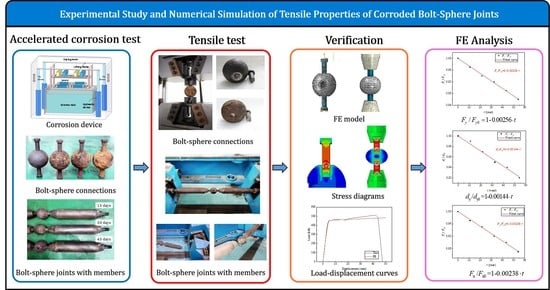Figure 1.
Corrosion cases for bolt-sphere joints: (a) Case 1; (b) Case 2; (c) Case 3.
Figure 1.
Corrosion cases for bolt-sphere joints: (a) Case 1; (b) Case 2; (c) Case 3.
Figure 2.
Bolt-sphere connections: (a) schematic of component dimensions; (b) typical bolt-sphere connections.
Figure 2.
Bolt-sphere connections: (a) schematic of component dimensions; (b) typical bolt-sphere connections.
Figure 3.
Bolt-sphere joints with members: (a) schematic of the component dimensions; (b) typical bolt-sphere joints.
Figure 3.
Bolt-sphere joints with members: (a) schematic of the component dimensions; (b) typical bolt-sphere joints.
Figure 4.
Accelerated corrosion tests: (a) schematic diagram of ZY-TL-C1 corrosion device; (b) accelerated corrosion device; (c) the joints placed on the lifting frame.
Figure 4.
Accelerated corrosion tests: (a) schematic diagram of ZY-TL-C1 corrosion device; (b) accelerated corrosion device; (c) the joints placed on the lifting frame.
Figure 5.
Corroded bolt-sphere connections.
Figure 5.
Corroded bolt-sphere connections.
Figure 6.
Corroded bolt-sphere joints with members.
Figure 6.
Corroded bolt-sphere joints with members.
Figure 7.
Failure modes: (a) uncorroded specimen; (b) corroded specimen.
Figure 7.
Failure modes: (a) uncorroded specimen; (b) corroded specimen.
Figure 8.
Fractures of individual specimens: (a) C-0; (b) C-1; (c) C-2; (d) C-3.
Figure 8.
Fractures of individual specimens: (a) C-0; (b) C-1; (c) C-2; (d) C-3.
Figure 9.
Fractures of individual specimens: (a) J-0; (b) J-1; (c) J-2; (d) J-3.
Figure 9.
Fractures of individual specimens: (a) J-0; (b) J-1; (c) J-2; (d) J-3.
Figure 10.
Load-displacement curves of the corroded bolt-sphere connections.
Figure 10.
Load-displacement curves of the corroded bolt-sphere connections.
Figure 11.
Load-displacement curves of the corroded bolt-sphere joints with members.
Figure 11.
Load-displacement curves of the corroded bolt-sphere joints with members.
Figure 12.
Diagram of the threads of a typical high-strength bolt.
Figure 12.
Diagram of the threads of a typical high-strength bolt.
Figure 13.
FE model of a typical bolt-sphere connection: (a) the whole model; (b) the bolt; (c) bolt hole.
Figure 13.
FE model of a typical bolt-sphere connection: (a) the whole model; (b) the bolt; (c) bolt hole.
Figure 14.
FE model of a typical bolt-sphere joint with members: (a) the whole mode; (b) the bolt-sphere; (c) the cone-head.
Figure 14.
FE model of a typical bolt-sphere joint with members: (a) the whole mode; (b) the bolt-sphere; (c) the cone-head.
Figure 15.
Load-displacement curves of the bolt-sphere connection from the test and FE.
Figure 15.
Load-displacement curves of the bolt-sphere connection from the test and FE.
Figure 16.
Stress diagrams of the bolt-sphere connection: (a) initial loading; (b) mid-term loading; (c) postloading.
Figure 16.
Stress diagrams of the bolt-sphere connection: (a) initial loading; (b) mid-term loading; (c) postloading.
Figure 17.
Load-displacement curves of the bolt-sphere joint with members from the test and FE.
Figure 17.
Load-displacement curves of the bolt-sphere joint with members from the test and FE.
Figure 18.
Stress diagrams of the bolt-sphere joint with members: (a) initial loading; (b) mid-term loading; (c) postloading.
Figure 18.
Stress diagrams of the bolt-sphere joint with members: (a) initial loading; (b) mid-term loading; (c) postloading.
Figure 19.
FE results of the corroded bolt-sphere joints with members: (a) w = 2.98%; (b) w = 3.56%; (c) w = 5.62%.
Figure 19.
FE results of the corroded bolt-sphere joints with members: (a) w = 2.98%; (b) w = 3.56%; (c) w = 5.62%.
Figure 20.
Load-displacement curves of the corroded bolt-sphere joints with members for different degrees of corrosion.
Figure 20.
Load-displacement curves of the corroded bolt-sphere joints with members for different degrees of corrosion.
Figure 21.
Fitting results against the service life, t, in years: (a) Fy/Fy0; (b) dy/dy0; (c) Fu/Fu0.
Figure 21.
Fitting results against the service life, t, in years: (a) Fy/Fy0; (b) dy/dy0; (c) Fu/Fu0.
Table 1.
Dimensions of bolt-sphere connections.
Table 1.
Dimensions of bolt-sphere connections.
| Parameters | d1 | d2 | d3 | d4 | d5 | d6 |
|---|
| Value/mm | 50 | 30 | 20 | 25 | 40 | 12.5 |
Table 2.
Dimensions of bolt-sphere joints with members.
Table 2.
Dimensions of bolt-sphere joints with members.
| Parameters | d1 | d2 | d3 | d4 | d5 | d6 | d7 | d8 | d9 |
|---|
| Value/mm | 50 | 30 | 27 | 35 | 55 | 17 | 20 | 88.5 | 435 |
Table 3.
Chemical composition of the parts (wt%).
Table 3.
Chemical composition of the parts (wt%).
| Parts | Material | C | Si | Mn | P | S | Cr | Ni | Cu | Al |
|---|
| Bolt | 40Cr | 0.38~0.44 | 0.20~0.24 | 0.64~0.68 | 0.013~0.024 | ≤0.008 | 0.94~0.98 | | | |
| Bolt-Sphere | 45 Steel | 0.42~0.5 | 0.17~0.37 | 0.5~0.8 | ≤0.04 | ≤0.04 | ≤0.25 | ≤0.3 | ≤0.25 | |
| Member | Q355 | 0.16 | 0.35 | 1.34 | 0.009 | 0.002 | 0.3 | 0.3 | 0.3 | 0.01~0.05 |
Table 4.
Results of the accelerated corrosion of the bolt-sphere connections.
Table 4.
Results of the accelerated corrosion of the bolt-sphere connections.
| Specimens | Time/Days | Initial Mass/kg | After Corrosion/kg | Mass Loss/kg | w/% |
|---|
| C-0 | 0 | 4.02 | 4.02 | 0 | 0 |
| C-1 | 15 | 4.03 | 3.92 | 0.11 | 2.73 |
| C-2 | 30 | 4.02 | 3.88 | 0.14 | 3.48 |
| C-3 | 45 | 4.05 | 3.87 | 0.18 | 4.44 |
Table 5.
Results of accelerated corrosion of the bolt-sphere joints with members.
Table 5.
Results of accelerated corrosion of the bolt-sphere joints with members.
| Specimens | Time/Days | Initial Mass/kg | After Corrosion/kg | Mass Loss/kg | w/% |
|---|
| J-0 | 0 | 15.35 | 15.35 | 0 | 0 |
| J-1 | 15 | 15.41 | 14.95 | 0.46 | 2.98 |
| J-2 | 30 | 15.44 | 14.89 | 0.55 | 3.56 |
| J-3 | 45 | 15.36 | 14.50 | 0.86 | 5.62 |
Table 6.
Results of the tensile properties of the corroded bolt-sphere connections.
Table 6.
Results of the tensile properties of the corroded bolt-sphere connections.
| Specimens | w/% | Fy/kN | dy/mm | Fu/kN | du/mm |
|---|
| C-0 | 0 | 225.89 | 0.87 | 273.24 | 7.26 |
| C-1 | 2.73 | 224.01 | 0.86 | 272.09 | 7.84 |
| C-2 | 3.48 | 219.07 | 0.84 | 267.53 | 7.65 |
| C-3 | 4.44 | 216.49 | 0.82 | 264.73 | 7.52 |
Table 7.
Results of the tensile properties of the corroded bolt-sphere joints with members.
Table 7.
Results of the tensile properties of the corroded bolt-sphere joints with members.
| Specimens | w/% | Fy/kN | dy/mm | Fu/kN | du/mm |
|---|
| J-0 | 0 | 455.21 | 5.39 | 508.28 | 40.79 |
| J-1 | 2.98 | 442.15 | 5.22 | 518.63 | 42.17 |
| J-2 | 3.56 | 423.71 | 4.93 | 515.27 | 41.24 |
| J-3 | 5.62 | 407.61 | 4.75 | 481.65 | 35.63 |
Table 8.
The corrosion rates of different steels in Beijing.
Table 8.
The corrosion rates of different steels in Beijing.
| Corrosive Environment | Corrosion Rate/μm/a |
|---|
| Q355B | 45 Steel | 40Cr |
|---|
| Atmosphere | 11 | 7.4 | 5.7 |
Table 9.
Parameters for the threads.
Table 9.
Parameters for the threads.
| Bolt | External Diameter/mm | Internal Diameter/mm | H/mm | P/mm |
|---|
| M20 | 20 | 17.294 | 2.165 | 2.5 |
| M27 | 27 | 23.752 | 2.598 | 3.0 |
Table 10.
Material properties.
Table 10.
Material properties.
| Part | Material | E/MPa | Poisson’s Ratio | fy/MPa | fu/MPa |
|---|
| Bolt-Sphere | 45steel | 210,000 | 0.3 | 355 | 600 |
| Bolt | 40Cr | 210,000 | 0.3 | 940 | 1150 |
| Member | Q355 | 210,000 | 0.3 | 410 | 550 |
Table 11.
Mechanical parameters of the corroded Q355B.
Table 11.
Mechanical parameters of the corroded Q355B.
| w (%) | E/MPa | fy/MPa | fu/MPa | εu |
|---|
| 0 | 210,000 | 410 | 590 | 0.2 |
| 2 | 205,737 | 399 | 571 | 0.193 |
| 2.98 | 203,648 | 393 | 561 | 0.189 |
| 3.56 | 202,411 | 390 | 555 | 0.187 |
| 4 | 201,474 | 388 | 551 | 0.186 |
| 5.62 | 198,021 | 379 | 535 | 0.180 |
| 6 | 197,211 | 377 | 532 | 0.179 |
| 8 | 192,948 | 365 | 512 | 0.172 |
| 10 | 188,685 | 354 | 493 | 0.165 |
Table 12.
Comparison of the FE and test results.
Table 12.
Comparison of the FE and test results.
| w | 2.98% | 3.56% | 5.62% |
|---|
| Test | FE | Deviation/% | Test | FE | Deviation/% | Test | FE | Deviation/% |
|---|
| Fy | 442.15 | 430.03 | −2.74 | 423.71 | 423.48 | −0.05 | 407.61 | 419.52 | 2.92 |
| dy | 5.22 | 5.15 | −1.34 | 4.93 | 4.72 | −4.26 | 4.75 | 4.49 | −5.47 |
| Fu | 518.63 | 458.4 | −11.61 | 515.27 | 453.65 | −11.96 | 481.65 | 449.72 | −6.63 |
Table 13.
Mechanical parameters of the corroded bolt-sphere joints with members.
Table 13.
Mechanical parameters of the corroded bolt-sphere joints with members.
| FE Model | w/% | Fy/kN | dy/mm | Fu/kN |
|---|
| FE-0 | 0 | 449.79 | 5.28 | 482.31 |
| FE-2 | 2 | 436.38 | 5.22 | 469.94 |
| FE-4 | 4 | 422.59 | 5.12 | 457.46 |
| FE-6 | 6 | 414.24 | 4.99 | 444.32 |
| FE-8 | 8 | 398.51 | 4.97 | 433.32 |
| FE-10 | 10 | 387.07 | 4.84 | 418.24 |
Table 14.
Results of normalization analysis on the bolt-sphere joints.
Table 14.
Results of normalization analysis on the bolt-sphere joints.
| w/% | t/year | Fy/Fy0 | dy/dy0 | Fu/Fu0 |
|---|
| 0 | 0.00 | 1.00 | 1.00 | 1.00 |
| 2 | 10.9 | 0.97 | 0.99 | 0.97 |
| 4 | 21.7 | 0.94 | 0.97 | 0.95 |
| 6 | 32.6 | 0.92 | 0.95 | 0.92 |
| 8 | 43.5 | 0.89 | 0.94 | 0.90 |
| 10 | 54.3 | 0.86 | 0.92 | 0.87 |

